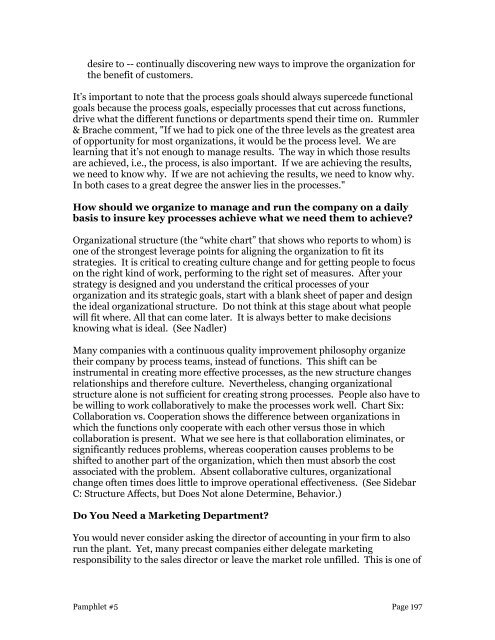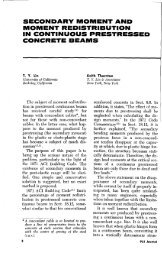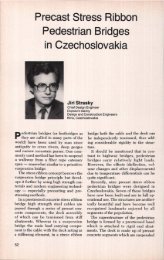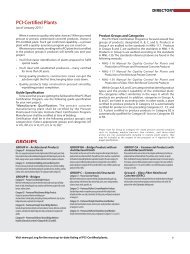Winning Without Competition: How to Break Out of a Commodity ...
Winning Without Competition: How to Break Out of a Commodity ...
Winning Without Competition: How to Break Out of a Commodity ...
You also want an ePaper? Increase the reach of your titles
YUMPU automatically turns print PDFs into web optimized ePapers that Google loves.
desire <strong>to</strong> -- continually discovering new ways <strong>to</strong> improve the organization for<br />
the benefit <strong>of</strong> cus<strong>to</strong>mers.<br />
It’s important <strong>to</strong> note that the process goals should always supercede functional<br />
goals because the process goals, especially processes that cut across functions,<br />
drive what the different functions or departments spend their time on. Rummler<br />
& Brache comment, "If we had <strong>to</strong> pick one <strong>of</strong> the three levels as the greatest area<br />
<strong>of</strong> opportunity for most organizations, it would be the process level. We are<br />
learning that it’s not enough <strong>to</strong> manage results. The way in which those results<br />
are achieved, i.e., the process, is also important. If we are achieving the results,<br />
we need <strong>to</strong> know why. If we are not achieving the results, we need <strong>to</strong> know why.<br />
In both cases <strong>to</strong> a great degree the answer lies in the processes."<br />
<strong>How</strong> should we organize <strong>to</strong> manage and run the company on a daily<br />
basis <strong>to</strong> insure key processes achieve what we need them <strong>to</strong> achieve?<br />
Organizational structure (the “white chart” that shows who reports <strong>to</strong> whom) is<br />
one <strong>of</strong> the strongest leverage points for aligning the organization <strong>to</strong> fit its<br />
strategies. It is critical <strong>to</strong> creating culture change and for getting people <strong>to</strong> focus<br />
on the right kind <strong>of</strong> work, performing <strong>to</strong> the right set <strong>of</strong> measures. After your<br />
strategy is designed and you understand the critical processes <strong>of</strong> your<br />
organization and its strategic goals, start with a blank sheet <strong>of</strong> paper and design<br />
the ideal organizational structure. Do not think at this stage about what people<br />
will fit where. All that can come later. It is always better <strong>to</strong> make decisions<br />
knowing what is ideal. (See Nadler)<br />
Many companies with a continuous quality improvement philosophy organize<br />
their company by process teams, instead <strong>of</strong> functions. This shift can be<br />
instrumental in creating more effective processes, as the new structure changes<br />
relationships and therefore culture. Nevertheless, changing organizational<br />
structure alone is not sufficient for creating strong processes. People also have <strong>to</strong><br />
be willing <strong>to</strong> work collaboratively <strong>to</strong> make the processes work well. Chart Six:<br />
Collaboration vs. Cooperation shows the difference between organizations in<br />
which the functions only cooperate with each other versus those in which<br />
collaboration is present. What we see here is that collaboration eliminates, or<br />
significantly reduces problems, whereas cooperation causes problems <strong>to</strong> be<br />
shifted <strong>to</strong> another part <strong>of</strong> the organization, which then must absorb the cost<br />
associated with the problem. Absent collaborative cultures, organizational<br />
change <strong>of</strong>ten times does little <strong>to</strong> improve operational effectiveness. (See Sidebar<br />
C: Structure Affects, but Does Not alone Determine, Behavior.)<br />
Do You Need a Marketing Department?<br />
You would never consider asking the direc<strong>to</strong>r <strong>of</strong> accounting in your firm <strong>to</strong> also<br />
run the plant. Yet, many precast companies either delegate marketing<br />
responsibility <strong>to</strong> the sales direc<strong>to</strong>r or leave the market role unfilled. This is one <strong>of</strong><br />
Pamphlet #5 Page 197







